A person without a shadow should keep out of the sun, that is the only safe and rational plan. -Adelbert von Chamisso
A few years ago, there was a rumor going around that the Earth's axis had shifted, and that we were no longer inclined to the Sun at 23.5°.
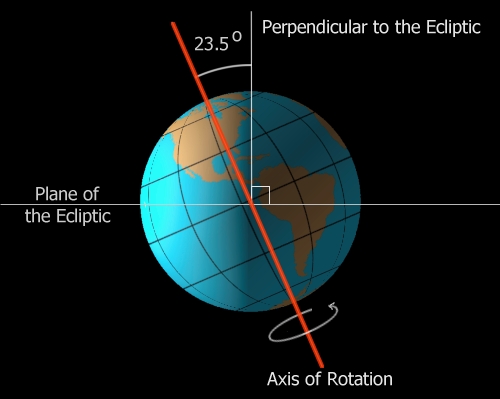
Well, guess what? Today, June 21st, like most June 21sts, is the Summer Solstice for the Northern Hemisphere. This means, for everyone (like me) living North of the Tropic of Cancer, this is the one day of the year where the Sun reaches its absolute highest point in the sky.
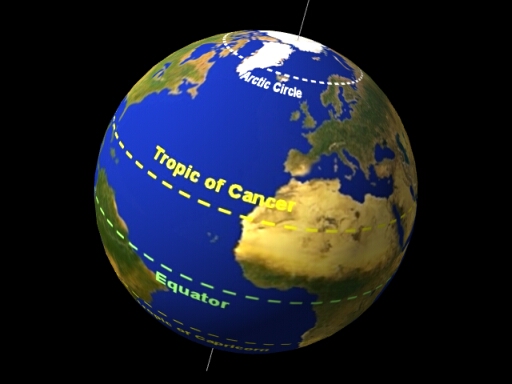
(If you're South of the Tropic of Capricorn, this will apply to you on December 21st.)
This is particularly interesting, because not only do you receive the greatest amount of daylight on the Summer Solstice, but because the Sun reaches its highest point in the sky, shadows of completely vertical objects reach their shortest length at (astronomical) noon on this day, as opposed to any other.
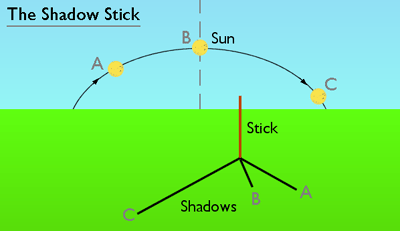
Back in ancient times, this idea that different latitudes had shadows of different lengths allowed us to measure the circumference of Earth for the first time.
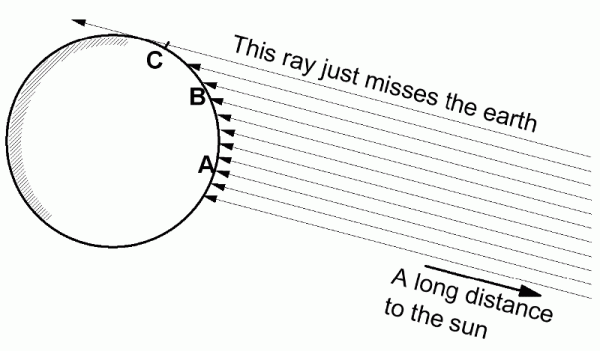
But we know the size of Earth quite well now, and we're also pros at measuring latitude and longitude.
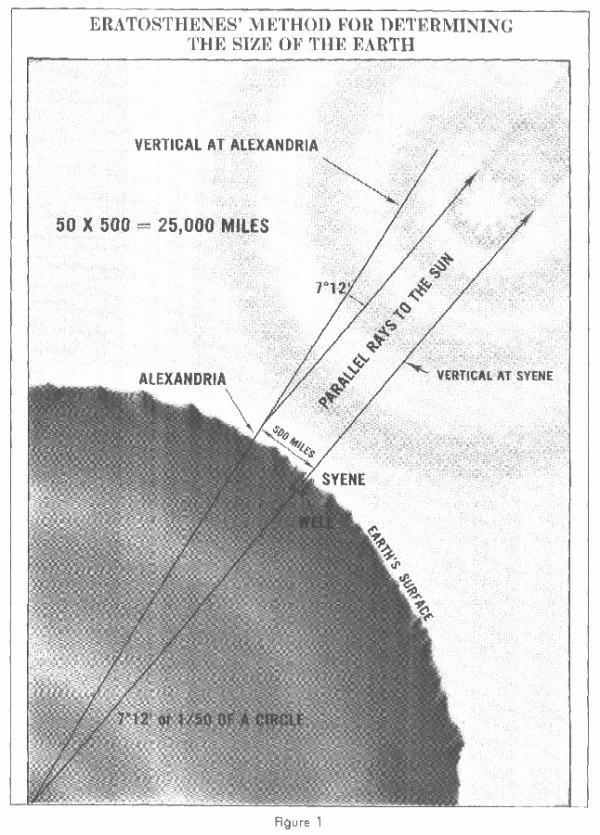
This means that we can use our stick and its shadow, combined with our knowledge of our latitude, to measure the tilt of the Earth!
How's that? It's pretty simple. All you have to do is measure what length your shadow is from a vertical object over the course of a day.
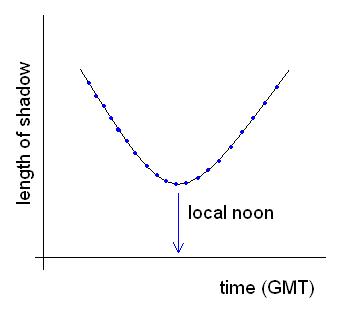
You'll find one point -- that corresponds to astronomical noon -- where the shadow is shorter than all others. If you use a little geometry, you'll realize you know the length of the shadow and the actual height of the stick, and so can figure out what angle the Sun is at when it reaches its highest point during the solstice.
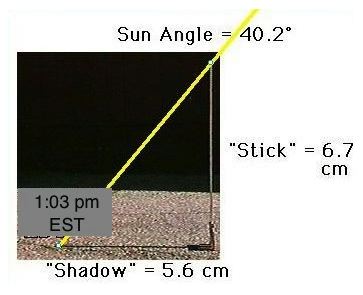
And that's it! Just subtract this angle from your latitude and you've measured the Earth's axial tilt! This is probably the easiest way to do it, and it works for everyone North of 23.5°. (Or, it would if we all had a sunny day!) And don't worry too hard if you missed today; you'll get some really close answers if you do it any time this week!
So happy Summer Solstice, but for those of you who have Winter Solstice today, I was ready for you six months ago!

Earlier today we saw the Summer Solstice. (I was awake at 1128 UTC.) The other hemisphere saw the Winter Solstice. To those few people straddling the Equator at the time, it was just a solstice.
In the northern hemisphere, our days are now getting shorter and our nights longer, but usually we don't hear this from network news weatherbozoes until the equinoxes. No one knows why.
Those of us in the tropics experience this twice a year on dates straddling the solstice. In Hawaiʻi they've named this "Lahaina Noon". The sun is passes directly overhead (though not actually at 12p) and there are no shadows for the vertical stick-like objects. It's kind of a nifty demonstration.
Nice post! But are you sure about that formula?
"Just subtract this angle from your latitude and you've measured the Earth's axial tilt!"
I keep noodling around with it and I can't get it to work.
How's this strike you?
tilt=latitude + sun angle-90
Consider right at 23.5 lat. The sun's angle will be 90 degrees.
20 degrees north of that, the sun's angle will be 20 degrees lower.
At the equinox, when the tilt toward the sun is zero, at the poles, you get tilt=90+0-90=0.
Do I have this wrong?
Never mind. You're defining "sun angle" as the difference between vertical and where the sun is, while I was thinking of it as the angle between the horizon and the sun.
Sorry to be picky, but as a matter of fact the Earth's obliquity isn't 23.5 degrees (hasn't been for ~500 years), but 23.438 degrees, and it bobs between 22 and 24 degrees over time. See, e.g., http://en.wikipedia.org/wiki/Tropic_of_Capricorn
Why most textbooks use the number that was determined during the explorations of the Renaissance, I haven't a clue.
Hi all;
Why does the inside of the human skull have really sharp blades of bone sticking out? Seems like there should be evolutionary pressures against it.
Are chromosomes in a cell, all linked together in one long chain, or are they free floating seperate pieces?
Mary lou...,
Hi, This hasn't much to do with the blog but I really need help. I'm doing a astronomy project using stonehenge as a reference and I can't find a way, without measuring my shadow, to find the Sun's angle compared to the date. Like The sun is at a 90 degree angle on the spring and fall equinoxes and at a 60 degree angle on summer solstice and a 120 degree angle on winter solstice but what about other dates? If you can help PLEASE send me an e-mail @ pibrittniebee@aol.com
THANKS! :)
Wondering if anyone can write about the significance of 23 degrees and a Celtic Cross.
I searched for "obliquity" on thefreedictionary.com and it said it was 23.27º
we have lived in the same house for 16 years, and every year at the summer solstice,the light that normally comes thru our south facing back door window,disappears. This year it has not disappeared, leading me to believe that indeed the earth's axial tilt has changed. How do you argue with that.
really nyc pics but i do suggest to show and specify the tilts actually both the tilts
News stations do not report the days of the solstices because of there association with Pagans maybe.
I have 2 diametrically opposed hung doors in my house.
Last year and maybe the year before #1 would swing open
by itself when almost closed and #2 was normal (stay where put). This year #2 swings shut when opened and #1 stays put.
I always wondered what caused this to happen. I can entertain a 22-24 degree shift possible, but with the polar ice melt and weight shift we may be experiencing an even larger axis shift here in 2013. Check predictions for 2013.
It'S A VERY USEFUL WEBSITE FOR STUDENTS. EVERY TYPE OF INFORMATION IS HERE.
I have a vertical post in the centre of my back garden. oN JUne 21st, for the past three years, I have marked the line of the shadow on the ground for each hour from 08:00 BST to (almost) 20:00. (Surrounding buildings prevent any earlier or later shadows.).I have marked each shodow line with garden wire and copied them on to a card. When I measure the angles (with a protractor) I get following increases of angle per hour from 08:00 to 18:00 , 15,15,20,25,25 25,25,20,15,5. How can I calculate what the angles should be. My latitude is 51.43924 and longitude is -0.348626. My age is 77 and you would think I had more sense, but I dont trust the government and what they tell us about time, or anything much else for that matter. I would like to work it out for myself! Thomas O. Devitt PhD
And what does this have to do with the climate change hoax?
Answer: Earth's angle of tilt has increased, and i won't go into polar shift.
Earth's axial tilt or obliquity varies from 24.5 degrees to 22.1 degrees over the course of a 41,000-year cycle. The current angle is 23.4 degrees. Changes in axial tilt affect the distribution of solar radiation received at the earth's surface. When the angle of tilt is low, polar regions receive less insolation. When the tilt is greater, the polar regions receive more insolation during the course of a year. Like precession and eccentricity, changes in tilt thus influence the relative strength of the seasons, but the effects of the tilt cycle are particularly pronounced in the high latitudes where the great ice ages began.
There is ongoing debate within the paleoclimate community as to whether these forces and their impact on insolation are sufficient to explain Ice Age dynamics.
http://www.ncdc.noaa.gov/paleo/ctl/clisci100ka.html
@Phil #17: Nice obfuscation there, not to mention a wonderfully trolling attempt a thread hijacking.
Let's take your numbers at face value, and do some really, really simple math. The obliquity varies by 2.4 degrees from its current value over 41,000 years. That's a change of 58 parts PER MILLION (0.0000585) per year.
The variation in obliquity and it's effect on multi-thousand year glaciation cycles is utterly and completely irrelevant to the discussion of the rapid (multi-decade) climate change observed and measured to high precision during post-industrial times. It is also irrelevant to the posting at hand.
I have been onto this subject for a couple years now, and yes the procedure is , as follows,known height / measured length of shadow, at highest point noon of SUN. also know in stair building RISE/N/RUN automaticallygive you slope, or angle, THEN, you must subtract your known latitude from.that result is TILT,.....then when you subtract that result from the given tilt,of 23.5 you will then know the differance... currently today 5-26-2015, I have concluded a change of 7.05 degrees ,now multiply by the four seasons ,we have 28.2degrees, as you see, this result is no longer the stated 23.5 degrees, on this date , we still havent reached the true summer solace yet, which of course happens on june 21,2015. you bet I will be checking thoes numbers as well.
K, thanks alot
But I have not satisfied by the TOPIC, Because most of the readings say "the axis of the Earth lies in 66.5 degrees"
IF THERE'S ANYMORE PLEASE HELP ME
THANKS ALL OF YOU FOR SHARING IDEAS TO THE TOPIC CONCERNED.
(90 - 66.5) degrees = 23.5 degrees = earths axial offset
I didn't know you @PJ
Why do you say (90-66.5)degrees =23.5degrees?
The tilt of the earths axis is 23.5 degrees, not 66.5 as you tried to point out in #20. So, by subtracting the result of 66.5 from 90, you get the true answer.
:)
can we make a crude apparatus to measure tilt!?
I was thinking of something for my kids to experiment with.
If I get a 15 foot tube thats 3inches in diameter, fix it so its pointing at polaris(since its our pole star) like an observatory. Attach the pole to a protractor and when we move the pole during the year we should get a reading on the protractor!?
would this work?
I'm going to measure a day late with my kids. There was no sun here today. We are going to drive 3 hours tomorrow. How could I compensate for the one day late variable? Thanks.
How do you have a 90 ° angle from a constantly static orbital plane from which we calculate a supposed axial tilt AND a constantly changing orbital angle from which we calculate solstice and equinox? I think I smell something.
@Jeni & Graham Darwin #26: What you smell is probably either ignorance or just lack of knowledge.
You are asking questions about two different reference frames. The orbital _plane_ is a "static" object. It is trivially defined mathematically as the plane which passes through three well-defined points in space: The center of the Sun, and the center of the Earth at two different (*any* two different) points along the Earth's orbit. That is a fixed plane, and the Earth's axis is at an angle different from 90 degrees to that plane.
Now, ask the question, "What direction does the Earth's axis point?" If you want to ask that question in a _fixed_ (not rapidly moving) reference frame, then you ask where does the axis point relative to the far distant stars. You'll discover, pretty quickly if you open your eyes and observe the sky, that the north end of Earth's axis points toward the star Polaris in the northern hemisphere. It points toward Polaris in January. It points toward Polaris in June. It points toward Polaris in October. It points toward Polaris all the time, every day, every year (at least for the next thousand years or so). That is a FIXED reference frame, and the Earth's axis is unchanging in that frame.
Now ask yourself a different question, "What angle does the Earth's axis make with respect to the line connecting the Sun and the Earth?" *This* angle changes through the year: in January, the north end of the axis (the North Pole) is pointing away from the Sun, so the angle is > 90 deg, and the axis is in the same plane as the line from the Sun to the Earth. In March, the North Pole is pointing "behind" the Earth's movement around the Sun, and the axis is in the plane perpendicular to the Sun-Earth line. In June, the North Pole is pointing toward the Sun, and the axis is back in the same plane as the Sun-Earth line, so the angle is < 90 deg.
What about the Navy's Astronomical Almanac? And remember February 17, 2009, when all had to switch to digital away from analog? Analog waves are easily disrupted by solar flares and electromagnetic radiation. The Navy's Almanac listed the obliquity at 23.0726 for February 17, 2009. The obliquity in the Almanac shows a decrease ever since. Hence, the need to move away from analog; it would be an ineffective mode of communication as the tilt decreased. Now, in the year 2016, the true obliquity is still listed 23.26 at the top of the column and yet! All this year the tilt is at 4 point something. Today is August 8, 2016, and the reported tilt, as calculated by the Navy, is 4.7962. The projected tilt for December 31, 2016, is 4.3566. If I could post attachments of the copies I made from the library, I would. Verify for yourself at the library. Info is not available online so far as I could find yet here is the link for your reference: http://aa.usno.navy.mil/index.php
Okay. So now what about Milankovitch cycles? Every few thousand years the Earth's magnetic field changes intensity and reverses, with the north and south poles abruptly flipping. We're due for one, aren't we. Because this would kind of make sense about the Mayan (or Aztec or whichever group you would like to give credit to first) Calendar ending in 2012. The next several years notes the accelerated change in the obliquity, setting up for the Milankovitch flip, restarting the clock for when the magnetic poles flip. When the obliquity hits zero, what happens? The Earth stops, solar radiation races through, the Moon keeps going, let's say it drops down or zooms to the next Star's gravitational field, and when it reaches the end of its tether with Earth, that's the powerful force, because of the interconnection - think tidal waves, that causes the Earth to restart as it will be swung around the Moon's (or the Moon around the Earth, or both?) thus allowing for the reversal in polarity. Yes?
why does he have a beard and why, just why. the moon and the sun is getting closer by the hour, we are all going to die!
Too many flies up y' nose, AAron; BIG blowies. Need to keep further away from th' cows.
{ ; > }
There is no axial tilt im afraid, its never been observed, this is just math based on the axiom that we orbit the sun, which obviously is not the case in reality.
Axioms are statements that we make up and declare to be true. There is no need to appeal to any higher power, we invent the rules and we call the rules axioms.
Math is invented and has nothing to do with the outside universe. It is a playground of human abstraction and critical thinking, and is at best inspired by the things we see around us.
The mathematical value of something is not its truthiness. The mathematical value of something is how interesting it is. Being true is not a thing that mathematics works with, we work with being consistent with the axioms we've invented and decided to be true.